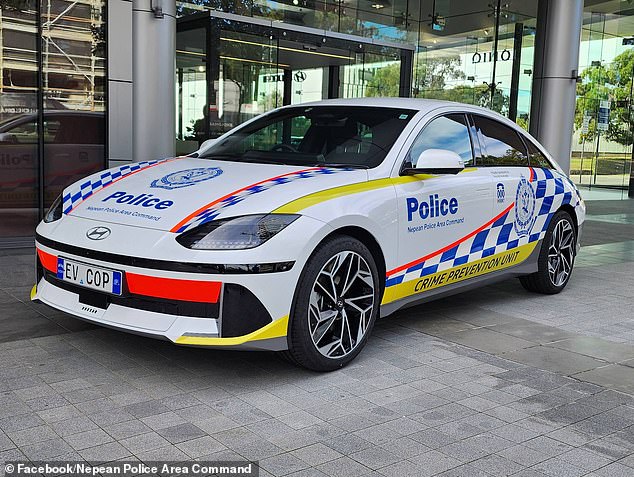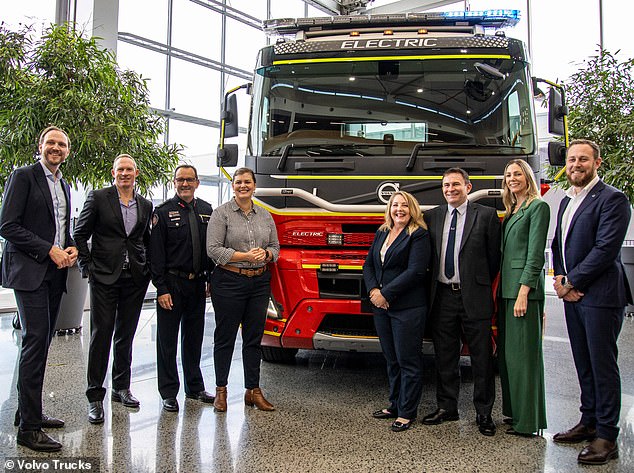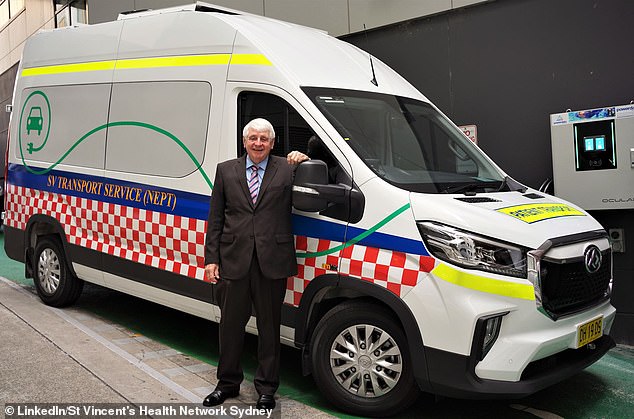NSW Police get a new electric vehicle as part of crime prevention unit
Emergency services have added electric vehicles to their fleets, while battery-powered police and ambulance cars are hitting the road.
A Hyundai Ioniq 6 electric sedan has been added to the New South Wales Nepean Police Area Command fleet for use in their Crime Prevent Unit.
The sedan, which the manufacturer lends to the police, will not be used in pursuits or road patrols.
The Nepean Police Area Command explained that officers would use the EV for their ‘daily duties’ within the community.
A Hyundai Ioniq 6 electric sedan has been added to the New South Wales Nepean Police Area Command fleet for use in their Crime Prevent Unit (pictured)

The sedan, on loan from the manufacturer, will be used by officers in their daily activities and can be seen on the streets with the license plates ‘EV COP’ (photo)
“Nepean Police Area Command has taken possession of a brand new Hyundai IONIQ 6, proudly sponsored by Hyundai Motor Company Australia,” the command wrote on Facebook.
“The vehicle will be used by our Crime Prevention Unit in their daily work within the community.
“We appreciate Hyundai Motor Company Australia’s commitment to supporting our efforts to maintain public safety and community engagement.”
NSW motorists will be able to see it driving around the streets with the number plates ‘EV COP’.
Although the EV’s specifications have yet to be revealed, Hyundai is offering the electric model in three variants with two batteries and the choice of rear- or all-wheel drive.
The Standard Range model, with a 53 kWh battery, claims a driving range of 429 kilometers. The Extended Range model, equipped with a 77.4 kWh battery, claims a driving range of 614 kilometers.
NSW Police previously introduced a Hyundai Kona electric SUV for community engagement in January 2021.
Last year, Queensland Police added a Kia EV6 to its fleet of highway patrol vehicles, while in 2022 Western Australian Police began using a Hyundai Ioniq 5 and a Toyota Mirai hydrogen fuel cell vehicle.
At the time, Queensland Police Assistant Commissioner Matthew Vanderbyl predicted that electric cars would be the future of police cars.
“I think that’s inevitable, I think we’re seeing a really accelerating uptake of electric vehicles within the broader community and there are good reasons for that, and I think we’re no different,” Deputy Commissioner Vanderbyl said in June 2023.
“We have operational implications that we have to work through as well, but I think we’ve really proven some of the previous technology with hybrid and plug-in hybrid as well.”
In 2019, Victoria Police added a Tesla Model However, it is believed that the EV is mainly used for promotional events.
Meanwhile, St Vincent’s Health Network Sydney introduced an electric LDV eDeliver 9 to its ambulance fleet early this year.
Meanwhile, Queensland Fire and Emergency Services introduced its first battery-electric fire truck to the Sunshine Coast fleet in early June: a Volvo 6×4 FMX Heavy Duty Electric Prime Mover.

It comes after Queensland Fire and Emergency Services introduced its first battery-electric fire engine to the Sunshine Coast fleet: a Volvo 6×4 FMX Heavy Duty Electric Prime Move (pictured)

St Vincent’s Health Network Sydney introduced an electric LDV eDeliver 9 to its ambulance fleet early this year (photo)
The EV fire truck was the second environmental purchase for the state, with a biofuel fire truck powered by hydrogenated vegetable oil hitting Townsville.
QFES commissioner Steve Smith said the emergency service wanted to reduce both operating costs and emissions.
Both the electric and HVO-powered trucks will be trialled at a non-critical level of response and operations, allowing us to assess the benefits of the vehicles before their further introduction into the fleet,” Ms Smith said in a statement.
‘There are approximately 500 heavy vehicles in the Fire and Rescue fleet and a further 1030 in RFS [Rural Fire Service]so this pilot plays a crucial role in shaping the approach we take to decarbonising our services.”
